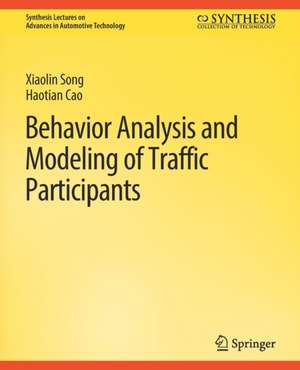Behavior Analysis and Modeling of Traffic Participants: Synthesis Lectures on Advances in Automotive Technology
Autor Xiaolin Song, Haotian Caoen Limba Engleză Paperback – 2 dec 2021
Din seria Synthesis Lectures on Advances in Automotive Technology
- 15%
 Preț: 529.60 lei
Preț: 529.60 lei -
 Preț: 444.13 lei
Preț: 444.13 lei -
 Preț: 132.34 lei
Preț: 132.34 lei -
 Preț: 381.43 lei
Preț: 381.43 lei -
 Preț: 259.41 lei
Preț: 259.41 lei -
 Preț: 259.41 lei
Preț: 259.41 lei -
 Preț: 259.57 lei
Preț: 259.57 lei -
 Preț: 380.07 lei
Preț: 380.07 lei -
 Preț: 447.84 lei
Preț: 447.84 lei -
 Preț: 415.57 lei
Preț: 415.57 lei -
 Preț: 414.42 lei
Preț: 414.42 lei -
 Preț: 412.13 lei
Preț: 412.13 lei -
 Preț: 260.18 lei
Preț: 260.18 lei -
 Preț: 381.98 lei
Preț: 381.98 lei -
 Preț: 486.42 lei
Preț: 486.42 lei -
 Preț: 106.07 lei
Preț: 106.07 lei -
 Preț: 259.04 lei
Preț: 259.04 lei -
 Preț: 447.24 lei
Preț: 447.24 lei
Preț: 416.54 lei
Nou
Puncte Express: 625
Preț estimativ în valută:
79.71€ • 86.56$ • 66.96£
79.71€ • 86.56$ • 66.96£
Carte tipărită la comandă
Livrare economică 23 aprilie-07 mai
Preluare comenzi: 021 569.72.76
Specificații
ISBN-13: 9783031003813
ISBN-10: 3031003810
Pagini: 160
Ilustrații: XII, 160 p.
Dimensiuni: 191 x 235 mm
Greutate: 0.3 kg
Editura: Springer International Publishing
Colecția Springer
Seria Synthesis Lectures on Advances in Automotive Technology
Locul publicării:Cham, Switzerland
ISBN-10: 3031003810
Pagini: 160
Ilustrații: XII, 160 p.
Dimensiuni: 191 x 235 mm
Greutate: 0.3 kg
Editura: Springer International Publishing
Colecția Springer
Seria Synthesis Lectures on Advances in Automotive Technology
Locul publicării:Cham, Switzerland
Cuprins
Acknowledgments.- Introduction.- Trajectory Prediction of the Surrounding Vehicle.- Predictions of the Intention and Future Trajectory of the Pedestrian.- Driver Secondary Driving Task Behavior Recognition.- Car-Following Driving Style Classification.- Driving Behavior Analysis Based on Naturalistic Driving Data.- Bibliography.- Authors' Biographies.
Notă biografică
Xiaolin Song received her B.E., M.E., and Ph.D. at the College of Mechanical and Vehicle Engineering, Hunan University in 1988, 1991, and 2007, respectively. From 2008 to the present, she has been a professor and a Ph.D. supervisor at Hunan University. She was an advanced visiting scholar of the University of Michigan (Ann Arbor), the University of Waterloo, and the University of Texas at Austin. She is a Vice-Chairman of the Rules Committee of Formula Student China, as well as an Academic Committee Member of the College of Mechanical and Vehicle Engineering, Hunan University. She has been an independent Principal Investigator(PI) and Co-PIs for multiple General Projects of the Natural Science Foundation of China (NFSC) and Hunan Provincial Natural Science Foundation, and dozens of other provincial and ministerial projects or industrial companies. Her research interests include the active safety of intelligent vehicles, vehicle dynamics control, driver behavior modeling, and human factors in driving safety.
Haotian Cao is currently a Postdoctoral Fellow at the College of Mechanical and Vehicle Engineering, Hunan University, Changsha, China. He received a B.E. in vehicle engineering and a Ph.D. in mechanical engineering from the College of Mechanical and Vehicle Engineering, Hunan University, Changsha, China, in 2011 and 2018, respectively. He was a visiting scholar at the Human Factors group, the University of Michigan Transportation Research Institute (UMTRI) from 2016–2017. He is currently a committee member of the Chinese Association of Automation Parallel Intelligence (2018–2022), and a referee of over 30 international journals and conferences. He is also the Principal Investigator of Youth Projects funded by the Natural Science Foundation of China (NFSC) and Hunan Provincial Natural Science Foundation, as well as Co-PIs for several projects from the NFSC and industry companies. His interests include trajectory planning and following control for intelligentvehicles, driver models, driver behavior modeling, and naturalistic driving data analysis.
